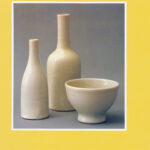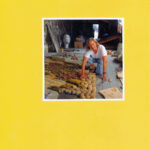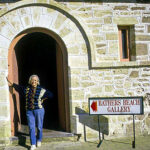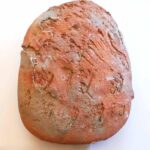I was one of five students who completed the Advanced Diploma in Studio Ceramics at Perth Technical College in 1988. Our final year Graduation Exhibition, held in the City Arcade in Perth, was opened by Joan Campbell. She gave a wonderful opening speech and praised us for the work we had created and the skills that we had acquired during our time at the Perth Technical College. Graduating and having my work exhibited for the first time were momentous events in my life, but meeting Joan Campbell that evening turned out to be an encounter that played an integral role in shaping my career as a potter.
After graduating I worked making garden pots with Robert Cripwell in his Fremantle Studio and I guess you could call it my orientation into a career as a potter. I worked alongside two other potters and a team of people preparing clay, loading kilns, and keeping the studio/factory running. After a few months throwing pots on piece rates the other two throwers in the pottery decided that the rates needed to be increased and put their proposal to Robert. Robert was not in agreeance, and it was decided that we should all cease work and go on strike. It was the first, and only time, in my life that I have ever been on strike, but I believed it was important to show my solidarity with the other throwers.
While I was on strike I visited Joan Campbell’s Bather’s Beach Studio. Joan remembered me from the Graduation Exhibition as soon as she saw me wander into her studio. I told her the story of the potters going on strike at Robert’s pottery and that I was on strike too. Joan immediately offered me a job helping her with a large commission that she had just secured for a major bank in Sydney. It sounded like a great opportunity, and I took the job and started working with Joan the next day.
During the 15 months that I worked with Joan, several commissions were created. They included one off architectural ceramic wall murals, large ceramic vessels, and a fountain sculpture that was commissioned by the St George Bank for their head office in Sydney. Joan also had a solo exhibition at the Fremantle Arts Centre while I was working with her and I had the job of creating many of the thrown elements incorporated in the exhibition.
Working with Joan was an inspirational time in my life. Not only because of how much I learned about ceramics, but also Joan’s work ethic, enthusiasm, and passionate approach to clay. Her principles and creative energy had a profound influence on my approach to working with clay and became the benchmark for my own career as a potter. Joan set high standards and expected this in return from me, an expectation that I was willing to meet. I was richly rewarded by Joan sharing her knowledge and philosophy about subjects ranging from clay to life in the arts and the importance of always striving to learn from, and to build relationships with, people from all walks of life.
I was fortunate to meet many artists during my 15 months at Bather’s Beach. Joan’s studio was a magnet for creative people from all over Australia and the international ceramic world. Every day was different, and Joan would always introduce me to the visitors and include me in the conversation and discussions over a cup of tea in the little kitchen area of the studio that looked out over the sea. I remember these moments fondly as Joan always had an entertaining way of describing her thoughts and recounting her journey working alongside many artists over her long career. Joan also had a fantastic collection of ceramic works from many of the artists that she had worked with. I felt very privileged to be able to pick up, examine and talk with Joan about the way in which the work had been created.
A few of the works that stand out in my mind are the large Peter Voulkos plate with holes through it that Joan had in her home and the Paul Soldner and Don Reitz vessels that were made at Bather’s Beach when they visited Joan in the late 70’s. These works embodied the energy and spontaneity that have been a foundation in my own ceramic practice and enabled me, at the time, to believe that it was possible to create thrown ceramic vessels in a fine art context.
Watching Joan create her large sculptural forms was a masterclass in its own right and to work with her on these forms was something that an 18-year-old arts school graduate could only dream of at the time. I reflect on this time as being the most profound time in my ceramic life and the fact that I still draw inspiration and energy from this experience speaks volumes of just how lucky I was to meet and work alongside Joan Campbell, but most of all, to be able call Joan my friend.




















